Intel’s Silvermont Architecture Revealed: Getting Serious About Mobile
by Anand Lal Shimpi on May 6, 2013 1:00 PM EST- Posted in
- CPUs
- Intel
- Silvermont
- SoCs
ISA
The original Atom processor enabled support for Merom/Conroe-class x86 instructions, it lacked SSE4 support due to die/power constraints; that was at 45nm, at 22nm there’s room for improvement. Silvermont brings ISA compatibility up to Westmere levels (Intel’s 2010 Core microprocessor architecture). There’s now support for SSE4.1, SSE4.2, POPCNT and AES-NI.
Silvermont is 64-bit capable, although it is up to Intel to enable 64-bit support on various SKUs similar to what we’ve seen with Atom thus far.
IPC and Frequency
The combination of everything Intel is doing on the IPC front give it, according to Intel, roughly the same single threaded performance as ARM’s Cortex A15. We’ve already established that the Cortex A15 is quite good, but here’s where Silvermont has a chance to pull ahead. We already established that Intel’s 22nm process can give it anywhere from a 18 - 37% performance uplift at the same power consumption. IPC scaling gives Silvermont stable footing, but the ability to run at considerably higher frequencies without drawing more power is what puts it over the top.
Intel isn’t talking about frequencies at this point, but I’ve heard numbers around 2 - 2.4GHz thrown around a lot. Compared to the 1.6 - 2GHz range we currently have with Bonnell based silicon, you can see how the performance story gets serious quickly. Intel is talking about a 50% improvement in IPC at the core, combine that with a 30% improvement in frequency without any power impact and you’re now at 83% better performance potentially with no power penalty. There are other advantages at the SoC level that once factored in drive things even further.
Real Turbo Modes & Power Management
Previous Atom based mobile SoCs had a very crude version of Intel’s Turbo Boost. The CPU would expose all of its available P-states to the OS and as it became thermally limited, Intel would clamp the max P-state it would expose to the OS. Everything was OS-driven and previous designs weren’t able to capitalize on unused thermal budget elsewhere in the SoC to drive up frequency in active parts of chip. This lack of flexibility even impacted the SoC at the CPU core level. When running a single threaded app, Medfield/Clover Trail/et al couldn’t take thermal budget freed up by the idle core and use it to drive the frequency of the active core. Previous Atom implementations were basically somewhere in the pre-Nehalem era of thermal/boost management. From what I’ve seen, this is also how a lot of the present day ARM architectures work as well. At best, they vary what operating states they expose to the OS and clamp max frequency depending on thermals. To the best of my knowledge, none of the SoC vendors today actively implement modern big-core-Intel-like frequency management. Silvermont fixes this.
Silvermont, like Nehalem and the architectures that followed, gets its own power control unit that monitors thermals and handles dynamic allocation of power budget to various blocks within the SoC. If I understand this correctly, Silvermont should expose a maximum base frequency to the OS but depending on instruction mix and available TDP it can turbo up beyond that maximum frequency as long as it doesn’t exceed TDP. Like Sandy Bridge, Silvermont will even be able to exceed TDP for a short period of time if the package temperature is low enough to allow it. Finally, Silvermont’s turbo can also work across IP blocks: power budget allocated to the GPU can be transferred to the CPU cores (and vice versa).
By big-core standards (especially compared to Haswell), Silvermont’s turbo isn’t all that impressive but compared to how things are currently handled in the mobile space this should be a huge step forward.
On the power management side, getting in and out of C6 should be a bit quicker. There's also a new C6 mode with cache state retention.


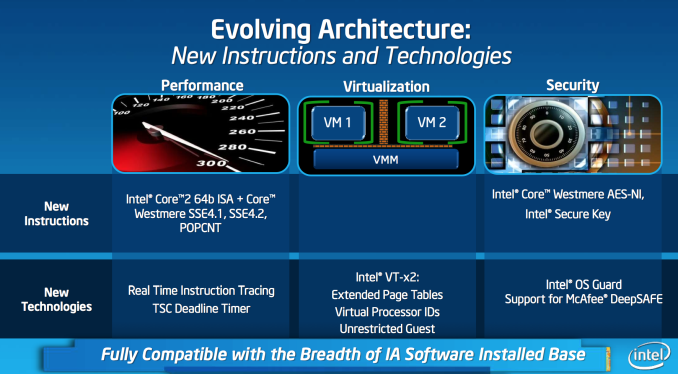
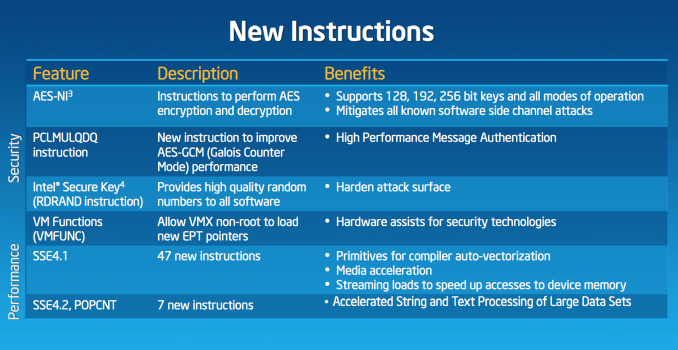
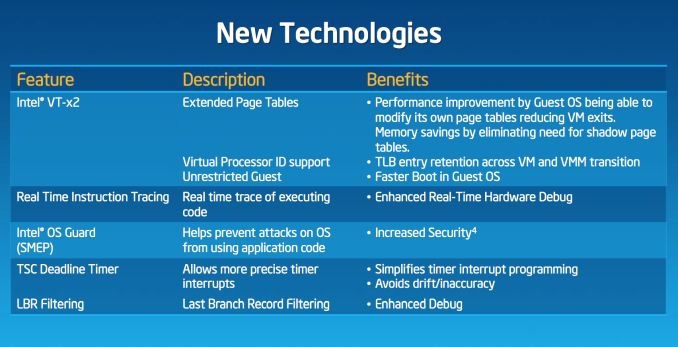
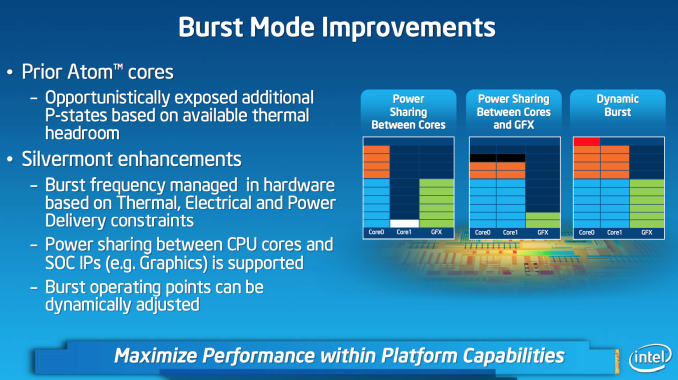
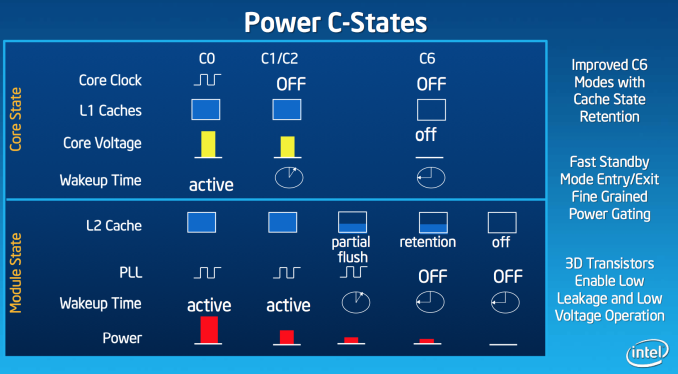








174 Comments
View All Comments
Kevin G - Monday, May 6, 2013 - link
Actually I've gotten the impression from Anandtech that Intel has been so tardy on providing chips for the mobile market that they may have lost the fight before even showing up. Intel may have good designs and the best foundries but that doesn't matter if ARM competitors arrive first with 'good enough' designs to gobble up all the market share. There is a likely a bit of frustration here constantly hearing about good tech that never reaches its potential.There was the recent line in the news article here about Intel's CEO choice about how Intel is foundry that makes x86 processors. That choice was likely selected due to Intel's future of becoming an open foundry to 3rd party designs. Intel has done this to a limited degree already. They recently signed a deal with Microsemi to manufacture FPGA's on Intel's 22 nm process. Presumably future Microsemi ARM based SoC + FGPA chips will also be manufactured by Intel as well.
Kidster3001 - Tuesday, May 7, 2013 - link
Intel has publicly stated that it's foundry business will never make products for a competitor. That means no ARM SoC's in Intel fabs.Kevin G - Tuesday, May 7, 2013 - link
Intel isn't active in the FPGA area, well there than manufacturing them for a handful of 3rd parties. The inclusion of an ARM core inside a SOC + FGPA design wouldn't be seen as a direct competitor. Indirectly it definitely would be a competitor but then again just the FPGA alone would be an indirect competitor.name99 - Monday, May 6, 2013 - link
Actually the REAL history is- Intel article appears. All the ARM fans whine about how unfair and awful it is, and how it refers to a chip that will only be released in six months.
- ARM article appears. All the Intel fans whine about how unfair and awful it is, and how it refers to a chip that will only be released in six months.
- Apple (CPU) article appears. Non-Apple ARM and Intel fans both whine about how unfair it is (because of tight OS integration or something, and Apple is closed so it doesn't count).
Repeat every six months...
Bob Todd - Tuesday, May 7, 2013 - link
Winner winner chicken dinner. I love how butt hurt people get about any article comparing CPU or GPU performance of two or more competitors (speculatively or not). I have devices with Krait, Swift, Tegra 3, Bobcat, Llano, Ivy Bridge, etc. They all made sense at the time for one reason or another or I wouldn't have them. I'm excited about Slivermont, just like I'm excited about Jaguar, and whatever Apple/Samsung/Qualcom/Nvidia cook up next on the ARM side. It's an awesome time to be into mobile gadgets. Now I'll sit back and laugh at the e-peen waiving misguided fanboyism...axien86 - Monday, May 6, 2013 - link
Acer is shipping new V5 ultraportables based on AMD's Jaguar high performance per watt technology in 30 days. AMD is 10 to 20 times smaller than Intel, but with design wins from Sony, Microsoft and now many other OEMs, they are delivering real performance for real value.
By contrast Intel really has nothing to show, but endless public relations to compensate for a history of company that has been upstaged by smaller companies like AMD in forging real innovations in computing.
A5 - Monday, May 6, 2013 - link
If by "high performance per watt" you mean "less performance in a higher TDP" than sure. Intel trounces AMD in notebooks for a reason.As for the Sony/MS stuff, I doubt Intel even bid for those contracts.
kyuu - Monday, May 6, 2013 - link
I hope you're kidding. Bobcat-based designs have been superior to Atom for forever, and if you take graphics performance into account, then Atom has been nothing short of laughable. I wouldn't be surprised if Silvermont beats Jaguar in CPU performance, but it'll be a small delta, and Jaguar is coming out a full half-year ahead of Silvermont.It's also nice that Intel might get GPU performance around the level of the iPad 4's SoC by the end of the year, but I believe AMD's mobile graphics already handily surpass that and the ARM world will have moved on to solutions that handily surpass that by then as well. So, yet again, Intel will be well behind the GPU curve. It won't be laughably bad anymore, though, at least.
And I really love that last line. "Intel didn't get some design wins? Well, psh, they totally didn't even want those anyway."
kyuu - Monday, May 6, 2013 - link
Oh, and also not sure why you brought notebooks up when we're talking about architectures for very low-power devices like tablets, netbooks, and maybe some ultrathins. No one would claim that Trinity/Richland is at the same level of CPU performance as Ivy Bridge/Haswell. Personally, though, I'd still prefer an AMD solution for a notebook for the superior graphics, lower price, and more-than-adequate CPU performance.xTRICKYxx - Tuesday, May 7, 2013 - link
This is where I want AMD to come into play. Their low power CPU's are so much better than Atom ever was, and always had superior graphics.